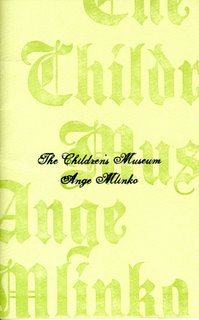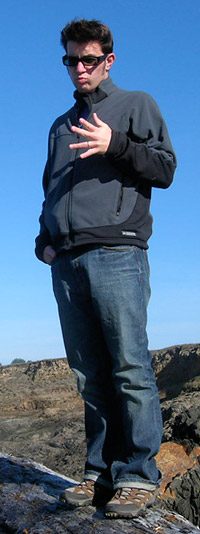
| Jacket 36 — Late 2008 | Jacket 36 Contents page | Jacket Homepage | Search Jacket |
The Internet address of this page is http://jacketmagazine.com/36/r-mlinko-rb-thomas-glass.shtml
Ange Mlinko
Starred Wire
and
The Children’s Museum
reviewed by Dan Thomas-Glass
Starred Wire. 82 pages. Coffee House Press. US$15. 1566891779. Paper.
The Children’s Museum. 18 pages. Prefontaine Press. Paper. c/o Ryan Murphy, 121 LaSalle St. #6, NY, NY 10027
This review is about 4 printed pages long. It is copyright © Dan Thomas-Glass and Jacket magazine 2008.See our [»»] Copyright notice.
1
Starred Wire is Ange Mlinko’s second book, and the one that cemented her status as nouveau-New York School. Bob Holman, the judge who selected the collection for the NPS, studs his review with the familiar list: ‘It’s a heady brew — O’Hara conversation, Ashbery sophistication, Koch hilarity, Schuyler shapeliness, Guest adventures, Notley grain, Mayer utopia, Padgett whimsy...’ The role-call too is heady — Mlinko: sum of a tradition. Nowadays people talk about talking about O’Hara when they talk about her poetry.[1] It’s a comparison that most poets not named William Logan[2] would welcome — but as a critic, one can’t help but be skeptical, seeing so much easy agreement. It’s a little creepy.
2
In any case, the opening strains of Starred Wire invite at least a variation on the comparison, when ‘Perhaps one wishes in Lisbon to be taken for a Brazilian / & have one’s picture taken by a gaggle of boys.’ Here, in the collection’s first poem Là, as often in Mlinko’s poetic, the surface texture of words precede and overtake any particularity of narrative, with the first line’s resolute /n/ phonemes carrying the reader across the varied landscape of the stresses, which could almost be read as a conga rhythm (thanks to John Tranter for contributing to the analysis of scansion and attendant Latin American rhythm here):
3
x / x / x x / / x x / x / x x / /
Perhaps one wishes in Lis-bon || to be taken for a Brazil-ian
Paragraph 4
The jauntiness of that one/in/bon/en/ian is Kochlear, but the poem’s reaching after imagination in the form of a city is pure Ashbery. Unlike the Guadalajara of Ashbery’s Instruction Manual, however, the Lisbon of Là refuses to cohere even for the length of a poem.[3] Fifty years later, the attention spans and distances are shorter, the people faster,[4] the work itself broken to smaller pieces. If the instruction manual of Instruction Manual provided an open-and-close frame for the dream of Mexico, here the dream interrupts itself:
5
or maybe you know Lisbon to be the place where peace is purchased
at the price of regular shop hours, so up the winding paths with lilacs
different from the kind you’re used to flippered over gates
giving off amazing scents that pierce you so in the first breath
you can’t capture them again in succeeding ones; then,
then you think You’re In Lisbon; or not until
you sit down for dinner and see twenty combinations of salt cod & potato
when a slim very black man from Mozambique strikes up
a conversation do you think you’re not in Lisbon? In Lisbon
there’s an Arab quarter; it borders on the Castelo
whose blue peacocks and white, white swans and black, tend lilies.

6
Amidst the brilliant description, ‘Lisbon’ is left a scrim for the kind of thinking that imagines coherent narratives of selves and cities — ‘You’re In Lisbon’ like Vegas stays in Vegas, on YouTube, experience just ‘Copies of copies,’ as The Docent of Evening puts it to close the book. By the end of Là, through sheer repetition any authentic Lisbon has faded, and you are instructed: ‘Prepare to dream of Fès. Go to Boston.’ This interchangeability of cities isn’t a new thematic playground for Mlinko; in her first full-length book, Matinées, the question was: ‘Aren’t I moving to New York, San Francisco, Seattle every day?’ Starred Wire bears several torches passed from that project: urbane, urban; ontological dislocation; the pop, the visual. And that attention to sound, mentioned above.
7
In these regards, among contemporary lyric poets Mlinko has few equals. To acknowledge the brutality of the administered world while still carving beauty of its excess is a thin line only a small minority are agile enough to walk. Those that make the attempt seem to have a collective interest in cities,[5] cities as machines for living writ large, cities as capital circulators, the system-systems. Certainly it is this interest that most directly ties Mlinko to her ur-predecessor, O’Hara: poems addressed ‘Dear Soho’ or titled Orders of Economies in New York comprise the streets and alleyways of Starred Wire, wandering the gregarious lunch breaks of the mind. But what becomes of the City Poet in the Country?

Ange Mlinko and child
8
This is the question and the anxiety at the heart of The Children’s Museum, a chapbook written in the wake of Mlinko’s move upstate,[6] an NYC poet no longer living in the city. The title conjures T-Rex skeletons on urban 4th-grade field trips, but the book is more country garden than museum. From Ryan Murphy’s Omahrahu one-press-one-project outfit, Prefontaine Press this time around, the chap comes swathed in a spring-green cover with slightly darker-green titles in a baroque font floating well off the page, and a properly centered title/author in a smaller cursive, a serene charcoal gray. The colors,[7] and the fonts, all speak of a latter-day Romanticism, emotions recollected at some kind of leisure. Though the opening poem of the collection, A Hike is the First Abstraction, again takes the reader to a series of European cities, ‘Quimper and Coimbra and Grenada,’ it is only to describe the angle of repose of ‘lemons amid suaveness of leaves.’ In the second poem, Two Philosophers, Spinoza’s Amsterdam begets ‘bumblebees working the bullseye / of the sunflower.’ Again and again the poet reaches for the cosmopolite’s points of reference to orient herself within ‘Nature.’ The collection’s penultimate poem, Brooklyn English, ends with the fear that motivates the approach:
9
But now, reader, get ready for
a real scene of horror:
There’s not a word demanded of you
by all this air and leafery. Not a word.
10
The poet built by cities is without city, and what becomes of the poems? One might say this is the logic of Romanticism reversed: the World is not enough with us, late & soon, / sitting and chilling we lay waste our powers.
11
If Ange Mlinko were only the sum of the New York School poets who grace every review of her work, the story might end there. But in the title poem, which closes the collection, the dislocation of the idyllic vision becomes that of scale, and ultimately the refocusing effort fuzzes the subject itself: ‘the shade breaks up beneath the oaks / tilting their gifts against the curriculum / of an armed galaxy. It slides into focus for the instant / I’m brrr, blurred.’ The self is not magically coherent in the face of a sublime Nature, but rather is stranded ‘among inventions, / with myself decked. Even mirrors are painted on.’ The multiple surfaces — of poem, of place, of person — shimmer, constructed and mediated out in the country as any point within the circulation of global capital. You can take the poet out of the city, it seems to say, but you can’t take the system out of anything. In The Children’s Museum, Ange Mlinko proves that her range is wider than the comparisons leveled at her, and in doing so offers new cartographies for contemporary poetry’s cognitive maps.
[1] http://www.newyorker.com/archive/2005/08/29/050829crbn_brieflynoted1
http://www.believermag.com/issues/200602/?read=review_mlinko
http://www.largeheartedboy.com/blog/archive/2006/03/book_notes_ange.html
[2] http://www.nytimes.com/2008/06/29/books/review/Logan-t.html?scp=2&sq=O%27Hara&st=cse
[3] Of course, in Ashbery’s Guadalajara the “band is playing Scheherazade by Rimsky-Korsakov” — which is to say ‘coherent’ shouldn’t be understood to mean ‘accurate’.
[4] http://janedark.com/2008/08/increasingly_shorter_sunday_or.html
[5] I’m thinking here, along with Mlinko, of Joshua Clover, Lisa Robertson, Michael Scharf, and Jasper Bernes, for their particular attention to the scope of the city itself—others with similar interests and intentions, like Ben Lerner or Juliana Spahr, might be said to have slightly wider-angle lenses.
[6] And, significantly, in the wake of being labeled as The New New York School.
[7] Ryan Murphy continues to astound with his ear for color—better perhaps than any other press out there. From the blue/white depth/sterility dialectic of Joseph Massey’s Within Hours to the painfully sensual red of Elizabeth Marie Young’s Sonnets, the colors, and their relationships to the poems, are exquisite.

Dan Thomas-Glass
Dan Thomas-Glass is a teacher and poet, and the editor and publisher of With + Stand (http://withplusstand.blogspot.com). His poems have appeared in BLACKBOX, Digital Artifact, Caffeine Destiny, Shampoo, Kitchen Sink, and Louis Liard, among others. His dissertation, on language poetry and rap, has been described as “an attempt to make a formal reading of the traces left by the seemingly-crushed desire for collectivity that rose out of urban politics and practice in the Sixties and Seventies.” He and his wife Kate live near Berkeley, CA.